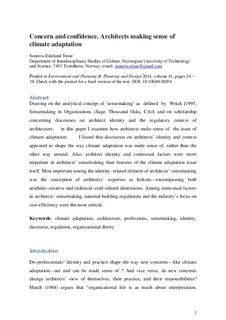Concern and confidence. Architects making sense of climate adaption
Journal article, Peer reviewed
Accepted version
Permanent lenke
http://hdl.handle.net/11250/2452040Utgivelsesdato
2014Metadata
Vis full innførselSamlinger
Originalversjon
Environment and Planning, B: Planning and Design. 2014, 41 (1), 24-38. 10.1068/b38054Sammendrag
Drawing on the analytical concept of ‘sensemaking’ as defined by Weick [1995, Sensemaking in Organizations (Sage, Thousand Oaks, CA)], and on scholarship concerning discourses on architect identity and the regulatory context of architecture, in this paper I examine how architects make sense of the issue of climate adaptation. I found that discourses on architects' identity and context appeared to shape the way climate adaptation was made sense of, rather than the other way around. Also, architect identity and contextual factors were more important in architects' sensemaking than features of the climate adaptation issue itself. Most important among the identity-related element of architects' sensemaking was the conception of architects' expertise as holistic—encompassing both aesthetic–creative and technical–craft-related dimensions. Among contextual factors in architects' sensemaking, national building regulations and the industry's focus on cost efficiency were the most central.
